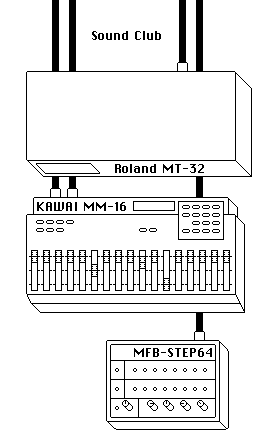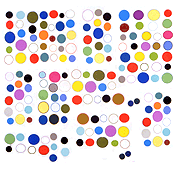"H.M.M.M. 2" [6.2 MB .mp3]

Remix of some live-in-the-studio music by Travis Hallenbeck. As described in an earlier post, his music setup includes a midi step sequencer, midi mixer, sound module (see YouTube demo), and a vocal synthesizer that responds unpredictably to audio from the above gear. The midi mixer doesn't just mix but changes parameters by altering control messages for pitch, delay, etc in real time. Hallenbeck works these sliders pretty hard so the music changes constantly and unpredictably.
The diagram above is from his flickr page. The vocal synthesizer is not in this diagram, and Sound Club (a tracker-like software sequencer) wasn't used in this recording.
My remixed version was done with Cubase, virtual reverb and a drum-sampler with my Sidstation kit. It's a fairly aggressive mix, cutting up the live recording and making loops that are then moved around to change order of the phrases, or repeat a phrase more times than it originally appeared. Aggressive in the service of bringing order to Hallenbeck's carefully-wrought chaos so there may be a tug of war of sensibilities here.
One thing I learned after the recording was how the sounds are produced by the Roland sound module: a late-'80s process called Linear Arithmetic synthesis, described on Wikipedia as follows: "a form of sample-based synthesis combined with subtractive synthesis, to produce its sounds. Samples are used for attacks and drums, while traditional synthesis assures the sustain phase of the sounds." Meaning the "attack transient" that makes, say, a characteristic piano sound is followed by a synthesized sustain that can be altered, filtered, and warped out like a synth.
This explains the slightly halting, lo-fi-but-not-to-the-point-of-being-raspy quality of the sounds. It's another of those abandoned avenues of technology, like 8-bit music (but more fleshed out) that became obsolete when chips got faster and could store more "complete" sounds. It's aesthetically interesting now because the clever and economical sound-generation method for most practical purposes no longer exists, making it pleasing and slightly exotic to ears attuned to today's slicker, fuller sampling regimens.
Hallenbeck's gear includes a current hardware step sequencer (the MFB Step-24) and my mixing software is new-ish so this is "hybrid" music rather than antiquarian.
Update, Feb 28: Made a few minor tweaks and reposted. Am resisting the urge to bump the volume to "CD level" as I think that will make it too harsh.
